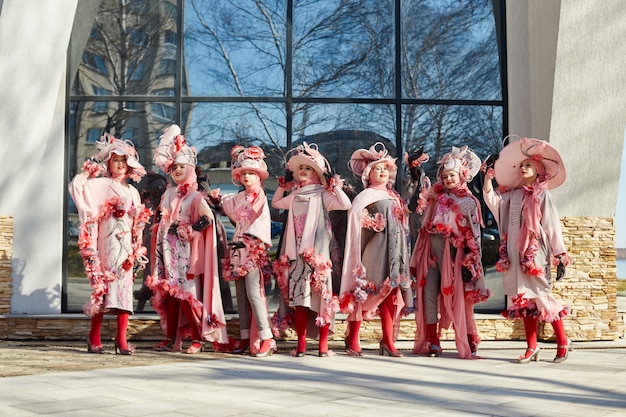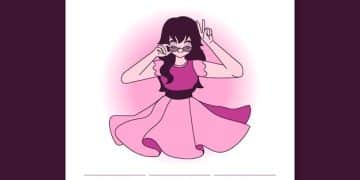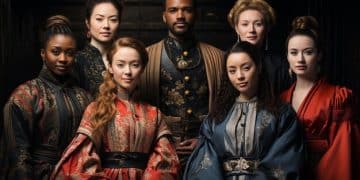The Rise of Female Leads in Chinese Dramas: Empowerment & Representation

Advertisements
The rise of female leads in Chinese dramas signifies a pivotal shift towards empowerment and diverse representation, reflecting changing societal values and offering compelling narratives that resonate globally.
The world of Chinese dramas, often referred to as C-dramas, has witnessed a significant and inspiring transformation in recent years. The rise of female leads in Chinese dramas: celebrating empowerment and representation, marks a departure from traditional portrayals, showcasing women in powerful, multifaceted roles that challenge stereotypes and resonate with audiences worldwide.
Anúncios
Exploring the Evolution of Female Characters in C-Dramas
Chinese dramas have a rich history, but the portrayal of women has evolved dramatically. Understanding this evolution is crucial to appreciating the significance of the rise of female leads. This section delves into the historical context and changing societal norms that paved the way for empowered female characters.
Traditional Roles and Stereotypes
Historically, female characters in C-dramas were often relegated to stereotypical roles, such as damsels in distress or supportive figures to male protagonists. These portrayals reflected traditional Confucian values, emphasizing women’s roles in the domestic sphere and their subservience to men.
Anúncios
The Shift Towards Independence
As Chinese society modernized, so did the representation of women on screen. The late 20th and early 21st centuries saw a gradual shift towards more independent and career-oriented female characters. However, these characters often still faced significant challenges and societal pressures, highlighting the ongoing struggle for gender equality.

Here are some Key aspects of the shift towards independence:
- Portrayals of women pursuing education and careers.
- Exploration of the challenges faced by women in male-dominated industries.
- Emphasis on female friendships and solidarity.
- Depiction of women challenging traditional family expectations.
Understanding the historical context and gradual shift towards independence provides a foundation for appreciating the full impact of the rise of female leads in contemporary C-dramas.
Celebrating Strong and Independent Female Leads
The current wave of C-dramas is characterized by the emergence of strong, independent female leads who defy traditional expectations. These characters are not only intelligent and capable but also possess agency and autonomy in their decisions. This section highlights some of the key characteristics and examples of these empowering female leads.
Characteristics of Empowered Female Leads
Empowered female leads in C-dramas are often defined by their intelligence, ambition, resilience, and independence. They are not afraid to challenge societal norms, pursue their dreams, and make their own choices, regardless of the obstacles they face.
Examples of Inspiring Characters
Many C-dramas have featured inspiring female leads who have resonated with audiences worldwide. These characters include career women, entrepreneurs, doctors, lawyers, and even historical figures who defied expectations and left a lasting impact on their societies.
- “Ode to Joy”: Showcases five unique women navigating life and relationships in Shanghai.
- “Nothing But Thirty”: Depicts the challenges and triumphs of three women turning thirty.
- “Go Ahead”: Features a heartwarming story with strong female family dynamics.
- “The Story of Ming Lan”: Presents a clever protagonist navigating palace intrigue.
By celebrating strong and independent female leads, C-dramas are contributing to a more diverse and empowering representation of women in media.
The Impact of Female-Centric Narratives on Viewers
The rise of female leads in C-dramas has had a significant impact on viewers, both in China and internationally. These narratives offer relatable experiences, inspire confidence, and promote positive social change. This section examines the various ways in which female-centric C-dramas have resonated with audiences.
Relatability and Identification
Female-centric narratives offer viewers the opportunity to connect with characters who share similar experiences and challenges. This relatability fosters a sense of understanding and validation, empowering viewers to feel seen and heard.
Inspiration and Empowerment
Watching strong and independent female leads overcome obstacles and achieve their goals can be incredibly inspiring for viewers. These characters serve as role models, demonstrating that women can be successful in any field and that their voices matter.

Promoting Social Change
Female-centric C-dramas can also play a role in promoting positive social change by challenging gender stereotypes and raising awareness about important issues such as gender equality, workplace discrimination, and domestic violence.
Key ways that Female-Centric Narratives promote Social Change:
- Encouraging open discussions about gender roles and expectations.
- Raising awareness about the challenges faced by women in different industries.
- Promoting a more inclusive and equitable society.
The impact of female-centric narratives extends beyond entertainment, contributing to a more empowering and socially conscious viewing experience.
Behind the Scenes: The Changing Landscape of C-Drama Production
The rise of female leads in C-dramas is not only a reflection of changing societal values but also a result of changes within the C-drama production industry. This section explores the influence of female writers, producers, and directors in shaping the narrative landscape.
The Role of Female Writers
Female writers bring unique perspectives and experiences to the table, crafting more nuanced and relatable female characters. Their contributions have been instrumental in creating stories that resonate with female audiences and challenge traditional stereotypes.
The Influence of Female Producers and Directors
Female producers and directors play a crucial role in ensuring that female-centric narratives are given the attention and resources they deserve. Their leadership can help to create a more inclusive and equitable industry, providing opportunities for female talent both on and off-screen.
Consider these factors regarding the influence of females behind the camera:
- Increased female representation in key production roles.
- Greater emphasis on female perspectives and experiences.
- Challenges in overcoming traditional biases within the industry.
The changing landscape of C-drama production, with more women in key roles, is contributing to a more diverse and empowering representation of women in media.
Addressing Challenges and Criticisms
While the rise of female leads in C-dramas is a positive development, it is important to acknowledge the challenges and criticisms that still exist. This section examines some of the common concerns surrounding female representation in C-dramas and explores potential solutions.
Concerns About Stereotypes and Tokenism
Some critics argue that even in female-centric C-dramas, female characters can still fall into stereotypical roles or serve as mere tokens of diversity. It is important to ensure that female characters are fully developed and have agency in their own stories.
The Male Gaze and Objectification
Another concern is the potential for the male gaze to influence the portrayal of female characters. Even in female-centric narratives, female characters can still be objectified or portrayed in ways that cater to male viewers. It is crucial to challenge these tendencies and prioritize female perspectives.
- Maintaining authentic representation amidst commercial pressures.
- Encouraging diverse storytelling and avoiding formulaic narratives.
- Addressing criticisms openly and striving for continuous improvement.
The problem of “Mary Sue” Characters
A common criticism aimed at some female lead characters is that they fall into the "Mary Sue" trope. These are often portrayed as unrealistically perfect, lacking flaws or struggling with personal conflicts, making them difficult to relate to and undermining their credibility.
Addressing these challenges and criticisms requires a commitment to thoughtful and nuanced storytelling that prioritizes female voices and perspectives.
The Future of Female Representation in C-Dramas
The future of female representation in C-dramas looks promising, with a growing demand for diverse and empowering narratives. This section explores the potential trends and developments that could shape the future of female characters in C-dramas.
Embracing Intersectionality
As C-dramas continue to evolve, there is an increasing need to embrace intersectionality, representing women from diverse backgrounds, ethnicities, sexual orientations, and abilities. This will ensure that all women are seen and heard in C-dramas.
Exploring Complex and Nuanced Characters
The future of female representation in C-dramas lies in exploring complex and nuanced characters who are not simply strong or independent but also flawed, vulnerable, and relatable. These characters will resonate with viewers on a deeper level and inspire meaningful conversations about womanhood.
Several factors will drive future trends:
- Growing demand for diverse and authentic representation.
- Increased collaboration between female writers, producers, and directors.
- Greater awareness of the impact of media on societal perceptions.
By embracing intersectionality and exploring complex characters, C-dramas can contribute to a more empowering and inclusive future for women in media.
| Key Point | Brief Description |
|---|---|
| 🌟 Evolution of Roles | From damsels to empowered leads reflecting social changes. |
| 💪 Impact on Viewers | Relatability, inspiration, and promotion of social change. |
| 🎬 Behind the Scenes | The influence of female writers, producers, and directors. |
| 🤔 Challenges | Stereotypes, male gaze, and “Mary Sue” characters need addressing. |
FAQ
▼
Societal shifts towards gender equality and a demand for diverse representation in media fueled the rise, supported by more female creators behind the scenes.
▼
They offer relatable experiences, inspire confidence, and promote discussions on gender roles, fostering a sense of empowerment and social awareness.
▼
Concerns include stereotypical portrayals, the influence of the male gaze, and characters being unrealistically perfect (“Mary Sue”), lacking relatability.
▼
They bring unique perspectives, craft nuanced characters, and ensure female-centric narratives receive the attention and resources they deserve, fostering inclusivity.
▼
The future aims for intersectionality, representing diverse backgrounds, and exploring complex, nuanced characters, promoting deeper connections and meaningful conversations about womanhood.
Conclusion
The rise of female leads in Chinese dramas: celebrating empowerment and representation, marks a notable and positive shift within the entertainment industry. By celebrating strength, independence, and diverse representation, these dramas resonate deeply with viewers, inspire positive change, and pave the way for a more inclusive and equitable future for women in media. The journey isn’t without its challenges, but the overall trend signifies a promising evolution in storytelling and representation.





